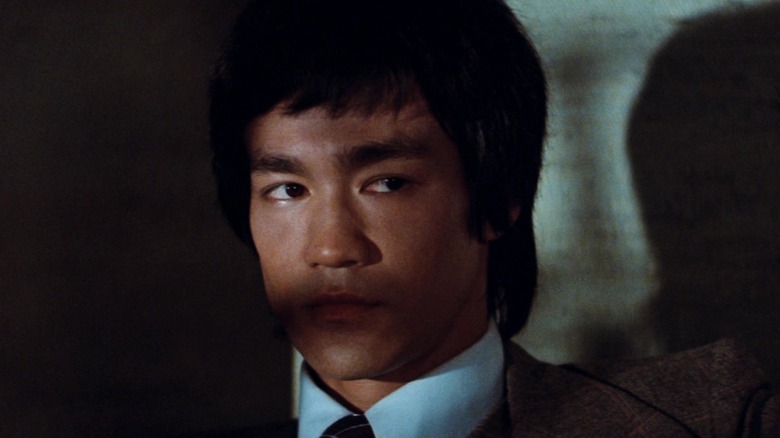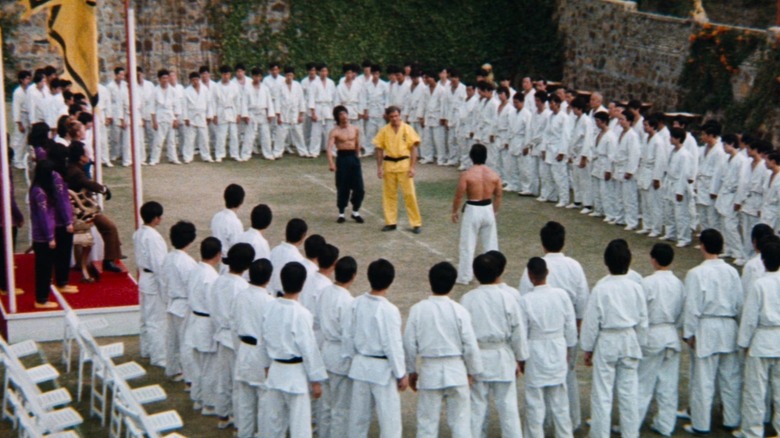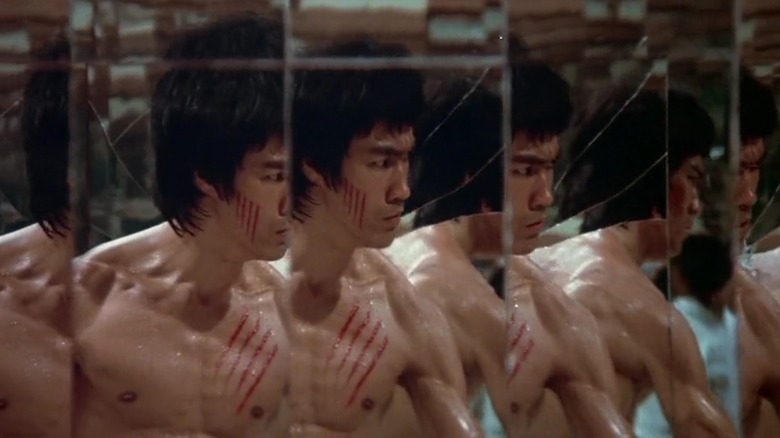The Climactic Brawl In Enter The Dragon Is The Best Action Scene Ever
(Welcome to Best Action Scene Ever, a column dedicated to breaking down the best, most effective action sequences throughout the genre. In this edition, we're breaking down the go-for-broke climax of "Enter the Dragon.")
So far, we've kept the focus of this column on the relatively recent past to highlight some of the most groundbreaking, visually inventive action sequences that filmmakers have innovated — thanks in large part, no doubt, to the wealth of inspirations throughout the decades that they were able to pull from. But what about the classics that practically invented the playbook in the first place? In this week's edition, we're taking things back to the '70s to give credit where it's due and pay homage to arguably the most influential martial arts movie of them all.
1973's "Enter the Dragon," directed by Robert Clouse, earned its reputation for many different reasons: from representing American audiences' first real introduction to the legendary Bruce Lee, to inspiring a whole swath of genre imitators, to the bittersweet fact that this would be Lee's final completed work before his untimely death. But more than anything else, its impeccably choreographed action and genuinely inspired premise — an amusingly James Bond-like villain holding a martial arts tournament on a remote island as a cover for recruiting members into his criminal empire — make it stand out and hold up today. No sequence better sums up the appeal of this incredibly successful box office hit than the final brawl that sees Lee take on an entire army of henchmen before dispatching the villain in one of the most challenging filming environments ever.
The scene
Sent to infiltrate the villainous Han (Kien Shih), both a nefarious drug lord and a disgraced former student of their Shaolin Temple, Mr. Lee's (Bruce Lee) luck finally runs out when he's captured after a lengthy series of fights and paraded out in front of Han's men for all to see. When he and another captive Roper (John Saxon) are commanded to fight each other to the death but refuse, leading to Roper's defeat of the imposing mini-boss Bolo (Bolo Yeung, who's built like Tom Hardy's Bane in "The Dark Knight Rises"), all hell breaks loose as Han sends in all of his minions to take out the dual threats once and for all.
What follows is a brilliantly staged exercise in organized chaos. Dozens upon dozens of stuntmen fill every inch of the screen, threatening to overwhelm our senses and cause us to lose track of Bruce Lee amid all the mayhem. Instead, we're treated to some of the absolute best moments the film has to offer, punctuated by Lee's primal yells, numerous zoom-ins to capture the martial arts legend's expressive face, and one of the most thrilling repudiations of the idea that "Less is more." This sequence is where restraint comes to die, along with hordes of henchmen who have the unfortunate luck to cross paths with a fully unleashed Lee.
It all crescendos when Han himself enters the melee, pulling from his bag of tricks and strapping on a claw hand to give him a leg up over our unstoppable — though never invulnerable — hero. That seemingly minor aspect, however, proves to be the reason why so much of this climactic scene works so well.
Why it works
Would it be too much of a copout to state that it all works simply because Bruce Lee in his prime was an absolute force of nature? While the choreography, staging, and the startling clarity of all the action all deserve due credit for the scene's effectiveness, viewers can't go far without acknowledging the sheer charisma and commitment on display by the action hero. The barely-contained sparkle in his eye as he lines up his next victim and that slight smile on his face after pulling off a successful chain of fight moves all help immortalize the performer as a true-blue movie star — but it's the fact that he isn't afraid to take a punch and shatter that illusion that truly puts this sequence over the top.
As much as he establishes himself as a one-man wrecking machine, Lee takes more than his fair share of damage along the way. Reminiscent of Keanu Reeves getting put through the wringer in each "John Wick" movie, Lee is never efficient enough to avoid injury altogether. That comes in stark relief when the one-handed Han finally has it up to here and enters the fray himself, armed with his makeshift claw weapon on one arm and focused entirely on taking our hero down. When Han quickly manages to land a blow on his opponent's face, Lee takes a beat to incredulously feel the blood on his face before launching into an even more frenzied attack.
Bereft of his weapon, Han uses the chaos to escape with Lee hot on his heels. Not coincidentally, this is the moment where "Enter the Dragon" enters all-timer territory.
The key moment
Crucially, everything slows down once Han and Lee face off once again within the villain's compound, the former now armed with Wolverine-like iron razors. The raucous noise and clamor of the previous moments are replaced with a deadly calm as the two size each other up, leading to a brutal hand-to-hand fight that leaves both combatants with plenty of damage. But just as our hero seems to take the upper hand, Han escapes into an inner room covered with countless mirrors. In yet another sequence that switches up the rules of engagement decisively, Lee is put on his back foot for a change as brute force is no longer enough to win the day.
The claustrophobic hall of mirrors set piece might remind younger viewers of similar moments in, say, "John Wick: Chapter Two" (which, yes, "Enter the Dragon" was invoked as a source of inspiration), but the early establishment of a "No guns" policy on Han's island sets the stakes even higher than most modern action movies. No random bullet fired from a distance will mark the end of either fighter; only a close-up and painfully intimate encounter at the end of each other's fists will do the trick.
The fraught scene derives as much tension out of the disorienting display of mirrors as it possibly can, leading Lee on a cat-and-mouse chase in plain sight to pull one over on Han before he can do the same to him. Again, Lee's vulnerability sells us on the dangers of the scene, even if we intuitively know the hero will come out on top no matter what. Lee does exactly that, forcing Han into the open and finishing him off with a well-placed kick impaling him on his own spear.
Action would never be the same again.


